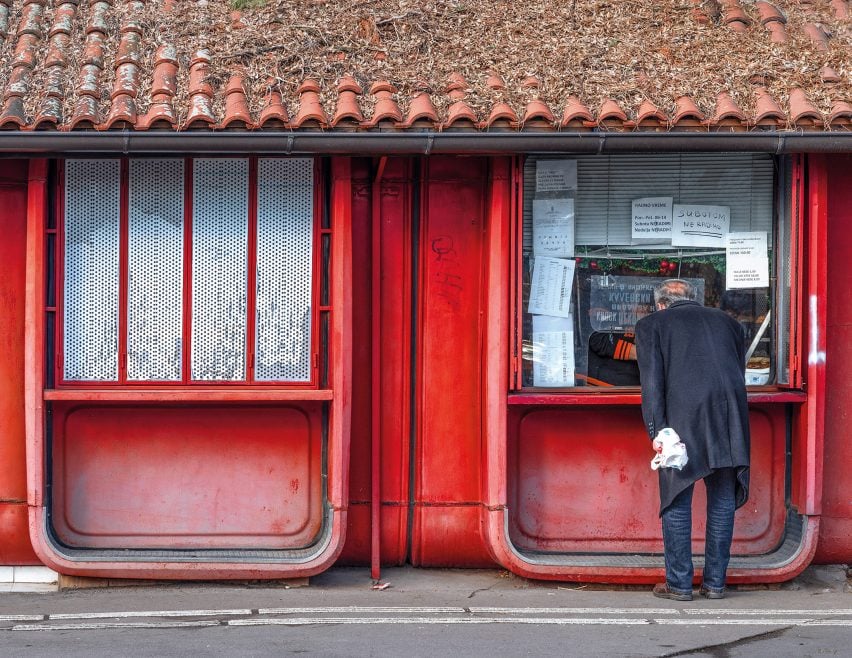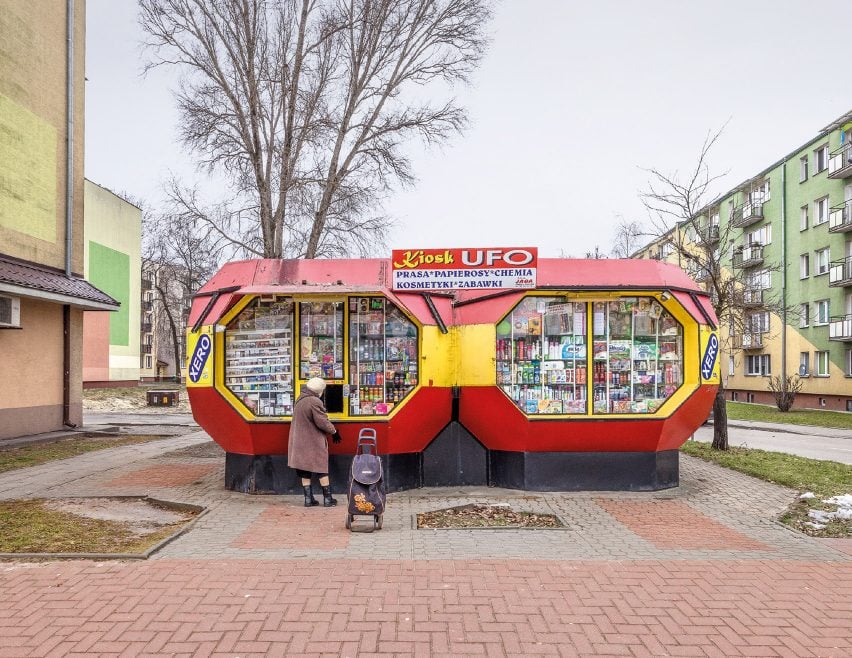Over 100 modernist booths that brighten streets across central and eastern Europe feature in the book Kiosk. Authors David Navarro and Martyna Sobecka shed light on the unusual structures and pick ten of the most interesting.
Kiosk compiles photos of 150 surviving modular kiosks that were built in factories and assembled in cities in the former Eastern Bloc between the 1970s to the 1990s.
It has been curated by Navarro and Sobecka, the founders of publisher and design studio Zupagrafika, who discovered the structures while documenting housing estates across central and eastern Europe for their previous publications.
During their travels, the duo discovered these modernist kiosks were once the beating heart of communities – used as everything from magazine stores to ice cream stands.
Among them are the influential K67 model by the architect Sasa J Machtig, and other versions such as the Polish Kami and the Macedonian KC190.
However, while some structures are being restored and repurposed today, their numbers are dwindling, with many now closed, removed or left to deteriorate.
Zupagrafika’s goal is for the book to help draw attention to the “timeless” designs of these playful structures, which it believes are deserving of a place in modern-day cities.
“Kiosk is a testament to a design that, like all great designs, remains timeless,” Navarro and Sobecka told Dezeen.
“We conducted short interviews with many of the owners or people working in these kiosks, and brief snippets of these interviews are featured in the book,” they continued.
“In many cases, they express pride in their kiosks,” the Zupagrafika founders added. “When we ask people for their memories, they tell us these kiosks were a window to a different world.”
Read on for Zupagrafika’s top 10 kiosks featured in the book:

K67, Slovenia
“The K67 kiosk featured on the book cover served as both an exhibit and a venue for civic activities at Anton Ukmar Square in Koper, as part of an initiative aimed at revitalising and activating the public space.
“We had the privilege of speaking with Saša J Mächtig, the designer of the iconic K67, who shared a press article showing him giving a lecture at the opening. He told us that, nearly 50 years after designing the second generation, he is now working on the third generation of the K67.
“Just a few days after we took this picture, the kiosk was removed.”

K67, Serbia
“This pekara, meaning bakery in Serbian, is in the district of Gornji Grad and is quite popular in Belgrade.
“While shooting there, we were surprised by the number of customers. Drivers and passersby frequently stop for a quick visit to order bread or local pastries. The modular kiosk is sheltered by a tile roof, which contrasts with the modernist design of the K67.”

Kami, Poland
“For decades, this Kami kiosk was used as a parking lot booth in Łódź, Poland, until its removal in 2023.
“Named after their manufacturer in Aleksandrów Łódzki, a town near Łódź, Kami were the Polish version of the K67. We took this photo several years ago while documenting the Śródmiejska Dzielnica Mieszkaniowa, also known locally as the Manhattan estate, a 1970s brutalist housing complex in the central district of Łódź.
“The woman walking in the photo was the ticket puncher, who had customised the kiosk with crochet curtains and was entering the booth after a break.”

UFO, Poland
“The UFO kiosk in Biała Podlaska, near the Polish-Belarusian border, is made from a two-module structure called a bathyscaphe.
“It used to sell a variety of items, including newspapers, cigarettes and toys, and served as a small drugstore offering cleaning products and cosmetics.
“The bathyscaphe systems were imported into Poland from the former USSR and are primarily made of metal, unlike the K67, which is made of reinforced polyfiber. Unfortunately, the business ceased operations a few months ago and while the kiosk remains, it is no longer functional.”

Bar Slavček, Slovenia
“While documenting modular kiosks, we became intrigued by what happens to these structures once they are removed from the urban grid.
“One example is this popular modular bar, Bar Slavček, in Novo Mesto, Slovenia. It closed down a few years ago and was relocated to a public area of a castle, where it awaits renovation.
“In Poland, there is a kiosk cemetery, but we only found newer kiosk models there, which were not relevant to our research. Recently, some K67 modules are being restored and later offered for rent or purchase.”

KC190, North Macedonia
“At the train platform of the Skopje Transportation Centre in North Macedonia, there is a row of KC190, or type KF, kiosks used as ticket vending points and staff offices.
“The complex was designed by Japanese architect Kenzo Tange as part of a broader brutalist approach to the city’s reconstruction plan following the 1963 Skopje earthquake. We were surprised by the rather derelict state of the complex.”

K67, Poland
“In Poland, K67 kiosks have often been referred to as Jugokiosk.
“You could buy virtually anything there, from cigarettes to farm eggs. In Piaskowa Góra Housing Estate, Wałbrzych, a row of Jugokiosks that previously sold eggs and vegetables now has only one operational unit, which serves as a cigarette vendor.”

K67, Croatia
“This K67 module serves as a storage unit and watchtower stand at a motocross track near the village of Židovinjak, Croatia.
“It had rained heavily the night before we took the shot, leaving some areas with puddles and muddy holes that were hard to spot.
“While David was taking pictures, he started sinking into one of these holes, up to his knees. In fact, this photo featured in the book was taken from inside the hole.”

KC190, Serbia
“One of the best-preserved KC190 kiosks we found in the former Yugoslav countries is at the Higher Technical School of Vocational Studies in the Pivara District of Kragujevac, Serbia.
“The KC190 modular kiosk series was designed by Aleksandar Nikoljski, an architect based in Skopje, in 1986 and was mass-produced by Treska Poliplast in Struga, North Macedonia.”

Kioski, Germany
“Kioski is an example of a successful use of a refurbished K-67.
“The kiosk, now serving as a coffee shop, was restored by K67 Berlin, a company specialising in reviving these modular stands. Silvia, who was working there at the time, invited us to try an espresso, which was excellent.”
The photography is courtesy of Zupagrafika.

